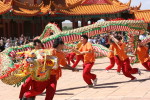3 International December Holidays You May Not Know About
Throughout history, what is now known as the month of December has almost always been a time for joining together with family, celebrating the season, and reflecting on the past year. There are dozens of different December holidays celebrated around the world. With this blog post, we decided to explore tranquil winter family celebrations from three different international cultures and religions. We at The International Center wish you a warm and wonderful holiday season, no matter which December holiday – or holidays – you celebrate!
Bodhi Day
Celebrated on the 8th day of the 12th lunar month of the Chinese calendar, or December 8 in Japan, Bodhi Day is a Buddhist holiday commemorating the day Siddhārtha Gautama, achieved enlightenment. According to ancient Buddhist tradition, Siddhārtha decided to sit beneath a fig tree and meditate until he was able to discover the root of all suffering, and how to liberate the self from this suffering. His enlightenment occurred in three stages. First, Siddhārtha realized that he had been reborn countless times, and discovered the cycle of rebirth and all of his past lives. Second, he discovered the Law of Karma: the importance of living one’s life by the rules of the Eightfold Path. Third, he discovered the Four Noble Truths, and finally reached Nirvana. Having experienced Nirvana, Siddhārtha became a Buddha, which means “Awakened One.” Traditional celebrations of Bodhi Day vary by different Buddhist sects, but services typically commemorate the Buddha’s achievement of Nirvana, and reflect upon what Nirvana means for Buddhism in the modern era. Observers often choose to commemorate Bodhi Day through meditation, study of the Dharma, chanting of Buddhist sutras, or the performance of altruistic acts towards other beings. Certain Buddhists celebrate Bodhi Day with a traditional meal of tea, cake, and readings from Buddhist texts.
Las Posadas
Beginning December 16 and ending December 24, Las Posadas is a 400-year-old Catholic tradition with origins in Spain. It is now celebrated mainly in Mexico, Guatemala, and the Southwestern United States. Historians believe that the celebration may have been started in the 16th century by Friar Pedro de Gante, a Belgian missionary, and may have begun as a combination of traditional Spanish Catholic themes with the Aztec celebration of the birth of Huitzilopochtli, the deity of war, sun, and human sacrifice. The nine-day celebration period mirrors the nine months of pregnancy: specifically the pregnancy of Mary carrying Jesus in Christian biblical and religious tradition.
Las Posadas revolves around a re-enactment of Mary and and her husband Joseph searching for a place to stay the night, as occurs in the bible.Two individuals dress up as Mary and Joseph, and certain houses in a neighborhood are designated as “inns.” A processional follows with “Mary” and “Joseph” to each house, where homeowners sing songs to Mary and Joseph, and turn them away, until the processional reaches the final “inn,” where they are finally allowed to enter. In certain cases, the final “inn” may be a church instead of a home. Individuals may act out the parts of Mary and Joseph, and some even ride real donkeys, followed by attendants dressed as angels and shepherds. Children carry poinsettas, and the procession is followed by musicians. At the end of each night’s journey, carols are sung and children break open star-shaped piñatas to find candy and fruit hidden inside, and there is typically a feast.
Pancha Ganapati
From December 21 – 25, many Hindus celebrate Pancha Ganapati, and hold a five-day festival in honor of Lord Ganesha, Patron of Arts and Guardian of Culture. Pancha Ganapati was created in 1985 by Sivaya Subramuniyaswami, as a Hindu alternative to December holidays like Christmas. Because the late Subramuniyaswami’s Śaivite Hindu church is located in Hawaii, celebration of Pancha Ganapati is not common among traditional Hindus in South Asia. Observers of Pancha Ganapati spend each of the five days focusing on a special “sadhana,” or spiritual discipline. They create shrines in the main living rooms of their homes, and decorate the shrine in spirit of the occasion. At the center of the shrine, a statue of Lord Ganesha is placed, and adorned with tinsel, lights, and ornaments.
Each morning of Pancha Ganapati, children dress or decorate Ganesha in a different color: golden yellow on the first day, followed by royal blue, ruby red, emerald green and brilliant orange. These are the colors of Lord Ganesha’s five shaktis (powers). On the golden yellow day, families sit together to fix strained relationships and make amends with one another for interpersonal suffering. The royal blue day is dedicated to sending apologies to relatives and friends in far-off places. The ruby red day is devoted to the settling of all debts and disputes with co-workers, managers, and employees. On the emerald green day, families discuss art, Hindu dharma, and make plans to further beautify their homes. Finally, on the brilliant orange day, families experience an outpouring of peace, love, and tranquility from Lord Ganesha himself, and open the gifts they have placed before the deity throughout the festival.
By Ephraim Rudolph, Marketing & Communications Intern

